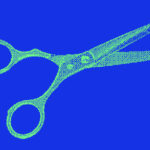
Just Like Us ambassador Rush Mittal explores the power of a haircut in an LGBTQIA+ person’s journey of self-discovery.
WORDS BY RUSH MITTAL

“When did you get the haircut?” It’s a question many trans-masculine and non-binary people have asked or been asked, an invitation to share a pivotal moment in our self-discovery journey.
Though haircuts might not commonly be major events in the lives of cisgender people, for many of us, this moment carries huge emotional weight. Growing up in India and Hong Kong, where beauty standards enforce rigid gender binaries, a simple haircut transformed into an act of rebellion in my childhood. In these cultures, where long hair is traditionally equated with femininity, choosing a short haircut defies norms ingrained over generations.
Interconnected with societal expectations, modern gender norms, and cultural implications, hair can speak more than words are capable of expressing. It can be a key part of exploring one’s personal gender expression.
That first haircut is often deeply tied to a reclamation of identity and can feel extremely empowering. It can be profoundly gender affirming, offering a sense of relief from dysphoria stemming from rigid, traditional, appearance-based gender expectations.
I never fully understood why cutting my hair shorter each time felt so liberating. With every trip to the salon, I felt more like myself. Ironically, I didn’t even begin to question my gender identity until three or four years after my first short bob — a cautious experiment with androgyny.
Of course, there’s no singular way to “look” trans or non-binary, but for many, including me, androgynous expression paved a path towards exploration. In many cultures, embracing androgyny is an act of rebellion, a subtle but powerful push against the boundaries of gender norms.
Though plentiful in Indian history, queerness is no longer embraced in modern society following centuries of colonial suppression. Generations after independence, many still cling to the rigid binaries that colonialism left behind. This societal pressure made it difficult for me to cut my hair any shorter than shoulder length, especially at 14 years old.
So, I waited.

Today, seven years later, much has changed — not only in my personal journey but in the world around us. I am now out and proud, identifying as trans-masc and non-binary, and I’ve explored various androgynous haircuts along the way.
What stands out to me is how, globally and even in countries like India, traditional gender norms are shifting. It’s becoming increasingly common for people to confidently experiment with androgynous styles, reflecting a broader cultural movement toward rejecting binary ideas of gender and embracing fluid expressions of identity.
With the influx of androgynous trends and the rapid rise in popularity of haircuts like mullets and wolf cuts, it feels liberating to walk into a salon in Mumbai and simply ask for what I want.
Less confined by outdated norms, these haircuts offer people an opportunity to explore their identities on their own terms. In India, where colonial legacies have long shaped conservative gender ideals, this change signifies a subtle but important reclamation of individuality.
Androgynous haircuts, for many, aren’t just a matter of aesthetics but a form of self-expression. They challenge societal expectations and offer a gateway to personal exploration and gender affirmation. What could seem like just a trend, actually opens the doWor to greater freedom and authenticity for people from all walks of life, and of all gender identities, pushing society toward a more inclusive future.
Rush is an ambassador for Just Like Us, the LGBT+ young people’s charity. Just Like Us needs LGBT+ ambassadors aged 18-25 to speak in schools – sign up now.
The post ‘The haircut that paved my path to self-discovery and helped me reclaim my identity’ appeared first on GAY TIMES.

0 Comments